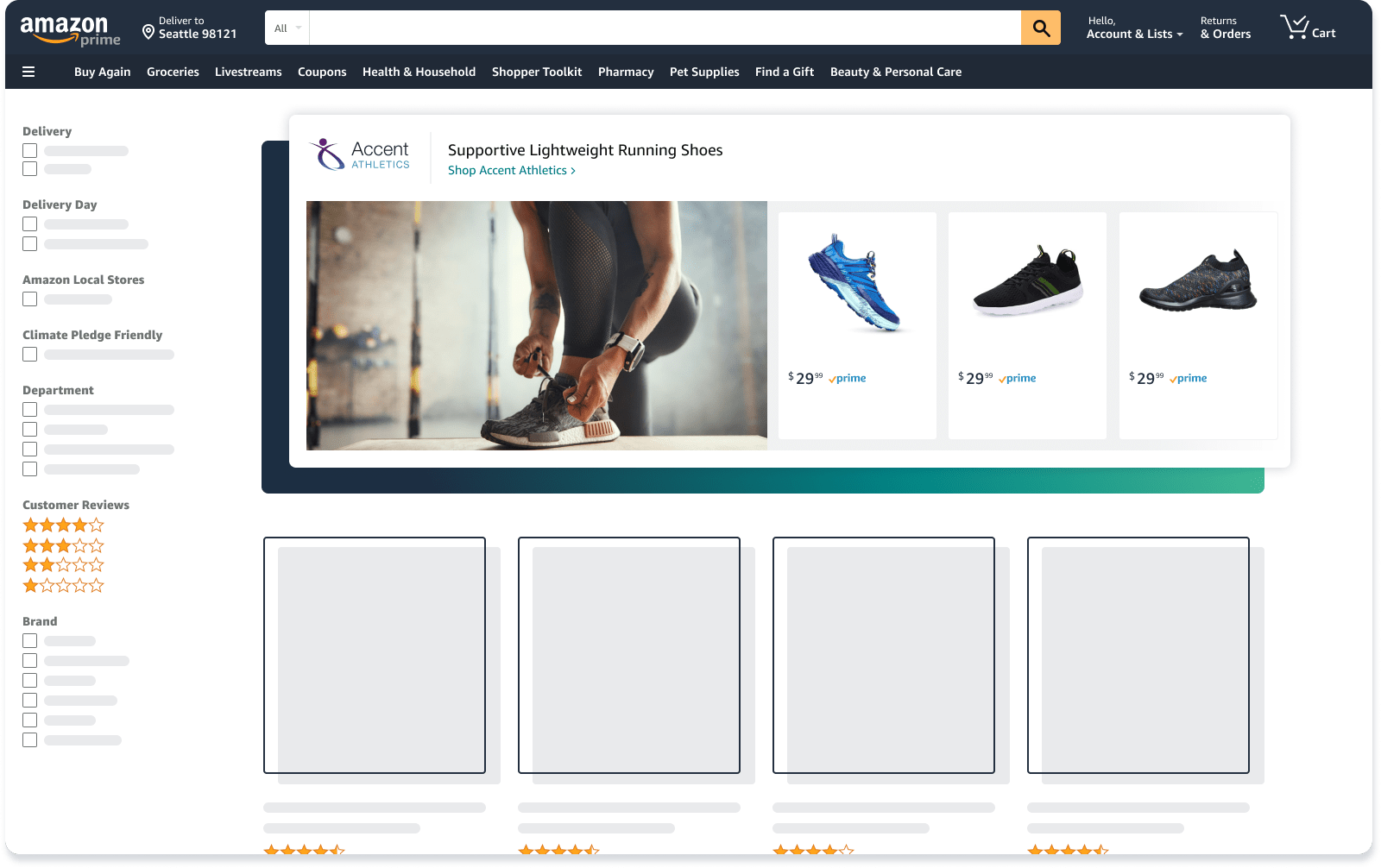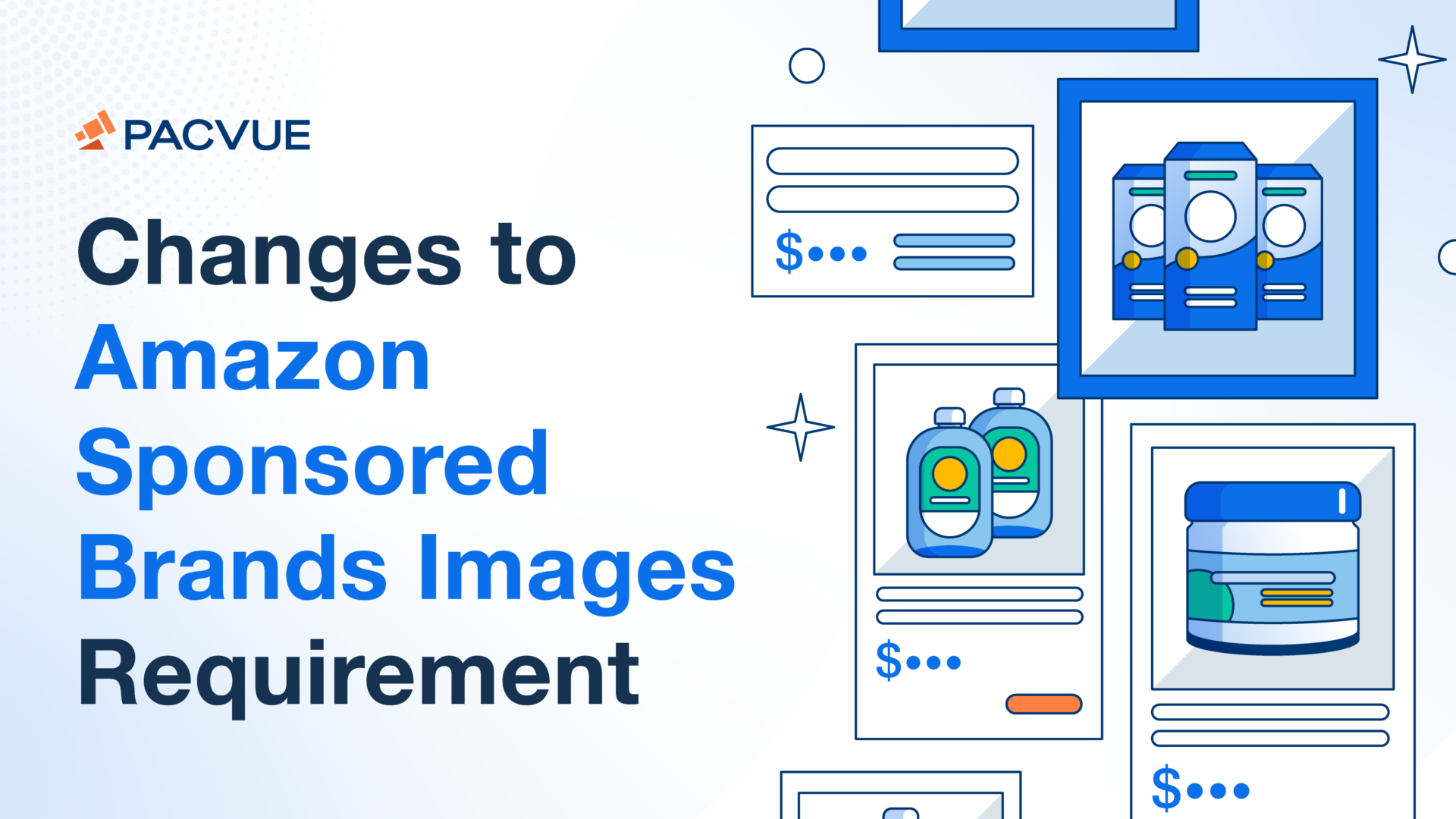If you haven’t heard the news, from August 31 2024, Amazon will no longer accept Sponsored Brand campaigns without custom creatives. This change means that any campaigns not utilizing custom creatives will no longer be eligible to serve Amazon Sponsored Brands ads. Whilst preparing for Prime Day, advertisers should take the opportunity to assess their Sponsored Brand campaigns, identify areas where visuals are needed, and start obtaining and implementing high-quality images before it’s too late.
What are Sponsored Brands Ads?
Amazon Sponsored Brands Ads are banner ads that display your brand logo, custom tagline, and multiple products, typically at the top of Amazon search results. Once clicked, Sponsored Brands ads will send customers to your storefront or landing page, where they’ll view your products and your products only. Sponsored Brands ads have become increasingly popular — today, 38% of third-party Amazon sellers use them, including 66% of sellers who’ve reached $1 million in lifetime sales.

What’s changing on August 31?
From August 31, Sponsored Brand campaigns without custom creatives will be turned off and will no longer be eligible to serve ads. Amazon’s decision to phase out ASIN Only Sponsored Brands campaigns signals a shift towards more visually engaging and personalized advertising. Here’s a breakdown of what this entails:
- No More ASIN-Only Campaigns: Advertisers can no longer rely solely on ASIN (Amazon Standard Identification Number) to create Sponsored Brands campaigns. Instead, they need to incorporate custom creative elements.
- Requirement for Custom Creatives: Custom creatives, including images, videos, and personalized branding, will become mandatory. As a result, advertisers must invest in high-quality visuals to represent their brand and products.
Benefits of Custom Creatives
While this change may seem daunting to brands, there are significant benefits to using custom creatives in their Sponsored Brands campaigns:
- Increased Engagement: High-quality visuals are more likely to catch the eye of potential customers, leading to higher engagement rates.
- Brand Differentiation: Custom creatives allow you to showcase your brand’s unique personality and value proposition, helping you stand out in a crowded marketplace.
- Improved Conversion Rates: Engaging and relevant visuals can improve the shopping experience for customers, leading to higher conversion rates and increased sales.
Steps Brands Need to Take
To comply with this new policy and continue leveraging Sponsored Brands ads, advertisers should take the following steps:
- Review Current Campaigns: Firstly, it’s imperative that brands manually review all existing campaigns to accurately identify which campaigns lack custom creatives and need to be updated.
- Develop Custom Creatives: To ensure compliance with the new regulations, brands must start developing custom creative elements for their campaigns. These images should reflect their overall brand and the season, if applicable. To accomplish this, brands may need to hire graphic designers, photographers, or videographers.
- Integrate Custom Creatives: Brands should then update their campaigns with the new creative assets. Each ad must be visually appealing and accurately represent your brand and products.
- Test and Optimize: Once the new creatives are in place, monitor the performance of your campaigns. A/B testing different creatives can help identify what resonates best with your audience, allowing you to optimize for better results.
- Link to the brand store: The best practice for Sponsored Brands campaigns is to link to the brand’s store. While making these changes, this may be an excellent opportunity to review and optimize your overall brand store to ensure it is providing an optimal customer experience.
Sponsored Campaign Best Practices:
While updating creatives to comply with this new regulation, brands should also take the time to incorporate best practices into their overall strategy.
Campaign Goals and Strategy
- Review Campaign Goals: Regularly reassess the objectives of your campaign. Sponsored Brand campaigns are highly effective at the lower end of the purchase funnel, where conversions are more likely. However, they also serve as excellent tools for increasing brand awareness.
- Category vs. Branded Campaigns: Decide whether your campaign will promote specific product categories or your overall brand. Adjust your strategy accordingly to align with your campaign goals.
Product and Promotional Strategies
- Review Promoted Products: If your campaign aims to promote specific ASINs (Amazon Standard Identification Numbers), regularly review and update the products to ensure that they are relevant and appealing.
- Link to Relevant Pages: If you direct traffic to your brand store, ensure the landing page is relevant to the advertised products. This improves user experience and can boost conversion rates.
- Prime Day Strategy: For significant events like Prime Day or the micro-season shopping events, prioritize promoting larger pack sizes and best-selling products. Consider creating a dedicated event page within your brand store to highlight these deals.
- Pricing Review: Ensure your pricing strategy is competitive and attractive, especially during critical sales periods.
- Repurpose National Media Campaigns: Integrate elements from national media campaigns into your Sponsored Brands campaigns for consistent messaging and broader reach.
- Early Launch of Campaigns: Initiate new campaigns at least 2-3 weeks before significant events such as Prime Day or Cyber Friday. This allows time for optimization and builds momentum leading up to the event.
Pacvue’s Solution
Are you feeling overwhelmed by all of this, and the steps needed to comply with this new rule? Pacvue has a solution to help you save time and enhance your Sponsored Brands campaigns on Amazon. Pacvue’s GenAI Tool, set to launch in Q3, is an innovative feature that transforms the development of creative assets, making the process faster and more cost-effective. By leveraging Amazon’s AI-powered technology, you can efficiently generate custom visuals during campaign setup using product images from your product detail pages (PDP), saving hours and streamlining asset creation. Simply select your products and enter keyword-aligned text prompts to expedite the setup process and create more targeted and seasonal ads. This simplicity has resulted in advertisers that use Image Generator increasing their campaign submissions by over 20%, testing multiple creative options to see what most resonates with customers and drives the most business impact. In fact, we’ve seen these advertisers experience a Gross Merchandise Sales (GMS) increase of nearly 5%, demonstrating the value of more relevant creatives for both shoppers and brands.
Conclusion
Amazon’s move to deprecate ASIN Only Sponsored Brands campaigns underscores the importance of having visually appealing creative assets on Amazon. While it is a significant shift, it also allows advertisers the opportunity to elevate their brand presence across Amazon. By investing in custom creatives and embracing this change, advertisers can create more compelling campaigns that will ultimately enhance consumers’ shopping experience and drive better business outcomes. Begin your transition today to stay ahead of the curve and maintain a competitive edge on Amazon.
Learn More
For more information on creating compelling custom creatives and optimizing your Amazon Sponsored Brands campaigns, book a call with Pacvue’s team of Retail Media experts.













